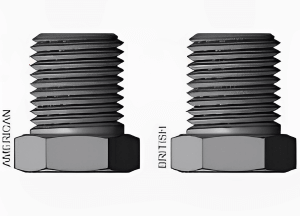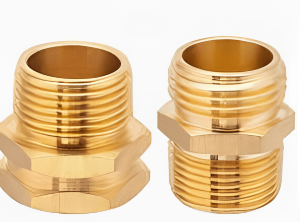In the world of plumbing and fluid systems, precision and compatibility are paramount. Two common terms that often arise are pipe thread and hose thread. While they may seem interchangeable, these threads serve distinct purposes and are essential components of fluid transport systems.
In this comprehensive article, we will delve into the nuances of pipe thread and hose thread, exploring whether they are the same, and providing insights into the process of conversion.
Understanding Pipe Threads and Hose Threads
Pipe Threads: Defining the Backbone
Photo 1: 60-degree angle thread Photo 2: 66-degree angle thread
Pipe threads are a fundamental element of plumbing systems. They are standardized threads used to create a secure and leak-resistant connection between pipes and various plumbing components. Pipe threads adhere to specific standards, such as NPT (National Pipe Taper) or BSP (British Standard Pipe), ensuring compatibility across different systems. These threads are typically found in applications where a permanent and sturdy connection is required, such as water supply lines or gas pipelines.
Hose Threads: Flexibility and Adaptability
Photo 1: GHT Photo 2: NPT
On the other hand, hose threads are designed for flexibility and adaptability. They are commonly found on hoses and connectors used in various fluid transport applications. Hose threads are often seen in scenarios where the connection needs to be easily detachable and reattachable, such as garden hoses or industrial hoses. The design of hose threads allows for a quick and secure connection without the need for specialized tools, making them highly convenient for users.
Distinguishing Features
Thread Structure
The most noticeable distinction between pipe threads and hose threads lies in their thread structure. Pipe threads are often tapered, meaning they gradually get narrower towards the end. This tapering creates a secure and tight seal when the threads are joined, preventing leaks. On the other hand, hose threads have a more uniform and parallel structure, making them suitable for quick and easy connections that can be repeatedly attached and detached.
Application Context
Understanding the application context is crucial in discerning the differences between these two types of threads. Pipe threads are favored in scenarios where the connection needs to be permanent and robust, ensuring the uninterrupted flow of fluids.
Hose threads, on the other hand, excel in applications where flexibility and ease of use are essential. They provide a hassle-free way to connect and disconnect hoses without compromising the integrity of the fluid transport system.
Converting Pipe Thread to Hose Thread
Converting from pipe thread to hose thread involves more than just changing the thread type. It requires careful consideration of the specific needs of the application. Here’s a step-by-step guide to the conversion process:
Assessment: Evaluate the nature of the fluid, the pressure requirements, and the need for a detachable connection.
Selecting the Right Adapter: Choose the appropriate adapter that can accommodate the conversion. Adapters come in various sizes and thread types.
Thread Sealant: Apply a suitable thread sealant to ensure a leak-free connection. Pipe sealant or thread tape can be used, depending on the application.
Connection: Carefully attach the adapter with the appropriate sealant to the existing pipe thread. Ensure a secure fit without overtightening.
Attaching the Hose: Once the adapter is in place, attach the hose with the corresponding hose thread to the adapter. Make sure the connection is snug but not excessively tightened.
Testing: Test the connection for any leaks or irregularities. Run water or fluid through the system to ensure the conversion was successful.
FAQs
Q 1: Can Pipe Thread and Hose Thread be Interchanged?
Pipe thread and hose thread are designed for different purposes and structures. Interchanging them without proper adapters and considerations could lead to leaks and compromised connections.
Q 2: Are Hose Threads Only Used in Garden Hoses?
Hose threads are not limited to garden hoses. They are used in a wide range of applications, including industrial hoses, firefighting equipment, and fluid transport systems.
Q 3: Can Pipe Thread be Converted to Hose Thread Easily?
Converting from pipe thread to hose thread involves selecting the right adapters and ensuring a secure connection. While it can be straightforward, careful assessment and proper sealing are essential.
Q 4: Are There Universal Adapters for Thread Conversion?
Universal adapters are available, but the selection should be based on factors such as thread type, size, and the specific application’s requirements.
Q 5: What Are Some Common Applications of Pipe Threads?
Pipe threads are commonly used in applications requiring permanent and secure connections, such as water supply lines, gas pipelines, and plumbing fixtures.
Q 6: Is Pipe Thread and Hose Thread the Same?
The short answer is no. Pipe thread and hose thread are not the same. They have distinct characteristics and serve different purposes within plumbing and fluid systems. While both threads facilitate connections, their design and functionality set them apart.
Conclusion
In the realm of plumbing and fluid systems, understanding the nuances of threads is essential for seamless and leak-free connections. Pipe threads and hose threads play distinct roles in these systems, with pipe threads providing a permanent and robust connection, and hose threads offering flexibility and convenience.
While they are not the same, the process of converting from pipe thread to hose thread requires careful consideration and appropriate adapters. By grasping the differences between these threads and their respective applications, you can ensure the efficiency and reliability of your fluid transport system.
Post time: Sep-14-2023



